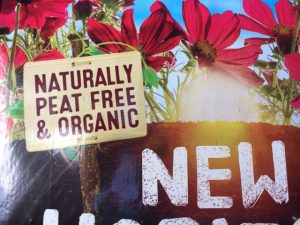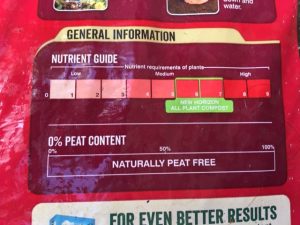Top Tips to go Peat Free
 There is no good enough reason to use peat in your garden or workplace.
There is no good enough reason to use peat in your garden or workplace.
Of course you’d expect me to say that – as an environmental consultant. But even the top gardeners agree – TV gardener Monty Don has described using peat in your garden as an act of eco-vandalism!
Go Peat Free
For years, gardeners have used peat-based compost to help plants grow big and strong.
Unfortunately, this is bad environmentally on a number of fronts. It is using non-renewable resources, depleting some of the last remaining peat-lands – indeed over 90% of the UK’s lowland peat bogs have been destroyed or damaged. It decimates wild ecosystems and a wealth of wildlife has disappeared.
Additionally, peat bogs store large amounts of carbon dioxide, so its release accelerates climate change.
Peat-free growing media, like compost and soil conditioners, are available at many garden centres and DIY stores. But they do still sell products using peat as their organic ingredient to a certain extent – even ‘low peat’ products claiming to be from ‘sustainable sources’ still contain a high proportion of peat, not to mention the soil in potted plants.
Top Tips on going Peat Free
1. Use alternatives – there are a number of peat free alternatives – these provide different conditions for growing depending on what you want to grow and the existing soil you have in your garden. Experiment with
– bark chippings,
– coir,
– wood fibre, and
– purchased or home-made compost.
2. Check the label – Always check the label on the compost – totally peat-free compost is usually well-labelled. If it’s not obvious on the front of the packaging, flip it over and check out the ‘small print’ on the back. Even low peat composts can have 60-60% peat in it – so beware!
Beware – it’s not just about the bagged soil; there may be peat in the pre-potted plants and shrubs, or in plant ‘plugs’, potted house plants or indoor potting mix too.
3. Ask for it – if you can’t find peat-free compost at your local shop, be vocal! The more we raise the issue, the more likely companies will respond to their customers’ needs. If they don’t stock it now, let them know you won’t simply purchase their exiting peat-based stock.
4. Compost your own green waste – Rather than purchasing peat-free compost, simply make your own. Use green waste from the garden and kitchen scraps like vegetable peelings. There are some great composters for sale, or it can be simple enough to make your own container. Just be careful to only use green waste – no meats, eggs or dairy, as these can attract vermin.
5. DIY potting compost mix – Monty Don encourages you to make your own potting compost – he says start with a measure of your own garden soil (important as it’ll have its own specific ecosystem), add a shovel or two of well-sieved garden compost, add horticultural grit liberally for good drainage, allowing free root-run for the growing plants. Check out Monty’s blog for Butterfly Conservation.
What is peat?
Peat is made up of decayed organic matter and vegetation, developing slowly under particular, wet conditions over thousands of years. Peat can be found in wetlands (bogs and moors), and its composition makes it home to a unique ecosystem.
Peat bogs are home to all sorts of plants, including colourful sphagnum mosses, the lovely but carnivorous plants like butterwort, and insect-friendly bog myrtle. They also provide an environment for rare dragonflies, spiders and other invertebrates, and a feeding ground for birds, such as golden plover, meadow pipit and skylark.
In terms of climate change, peat-lands act like a sponge, absorbing carbon from the atmosphere and storing it like a sink. The UK’s peat-lands store around 3.2 billion tonnes of carbon. After oceans, they are the second largest store of carbon on the planet.
Is it worth it?
Many gardeners insist that peat is necessary to having a lovely garden. But we have to question whether it is worth it in a world of a climate and ecological emergency. The alternatives I mention here are still great for growing healthy and diverse plants. While your perennials may not bloom quite so brightly, you can still make the best environmental choice.
Pledge to go peat free
The Wildlife Trusts are running a campaign encouraging people to go peat free. Sign the pledge here.
Or sign the petition telling the government to step in to make retailers stop selling peat-based products.
Your Garden AND Your Workplace
Don’t forget this equally applies to the outside space at your work. If your company is responsible for grounds or gardens, tell your colleagues or your contractor that your business is going peat free.
Then shout about it to your staff, your customers and others. The more everyone knows there is a useful and successful alternative to peat, the sooner we have address this important issue.


